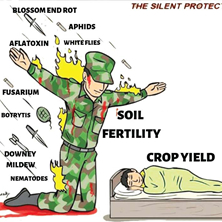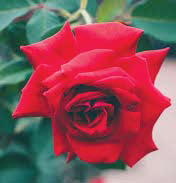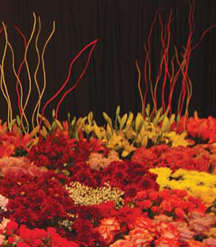Featured Past Articles
Fertilizers are responsible for over half of global food production, but there are areas in world with nutrient deficiency and other areas of nutrient excess. Managing soil fertility requires careful application of science and skill to meet production, environmental, and social goals. Writes By Dr. Rob Mikkelsen, Ph.D. (Soil Science)
 Getting crops off to a good start is critical for achieving high yields. During this early stage of growth, seedlings are especially vulnerable to many environmental and biological stresses. Protecting plants from stress and disease begins with providing balanced nutrition from planting through harvest. The critical link between plant nutrition and disease resistance has become apparent as the frontiers of plant health are better understood. A few of these examples are explained here:
Getting crops off to a good start is critical for achieving high yields. During this early stage of growth, seedlings are especially vulnerable to many environmental and biological stresses. Protecting plants from stress and disease begins with providing balanced nutrition from planting through harvest. The critical link between plant nutrition and disease resistance has become apparent as the frontiers of plant health are better understood. A few of these examples are explained here:
Potassium
Potassium plays an essential role in many well-recognized metabolic processes for plants. Potassium’s contribution to sustaining high yielding crops with top quality is well understood. However, the role of potassium in plant stress resistance is less known and appreciated. Potassium is unique among the essential mineral nutrients in its role for plant survival against environmental stress, pests, and diseases.
Supplying adequate potassium to crops through proper fertilization is a simple way to lower the requirement for pest-control treatments that may be costly, timeconsuming, and troublesome. The frequently observed benefits of potassium on plant health were reviewed by Wang et al. (2013), which summarizes many recent scientific studies.
Read more: Why Soil Fertility is the #1 Defense Against Crop Pests & Disease
In Drive to Secure International Horticultural Markets Through Management of Quarantine Pests
By KNA
 The Kenya Plant Health Inspectorate Service (KEPHIS) is working with over 200 horticultural produce exporters to the European Union (EU) and Australian markets to formulate strategies to curb False Codling Moth (Thaumatotibia leucotreta) pest which has led to some rejection of the country’s products at international markets.
The Kenya Plant Health Inspectorate Service (KEPHIS) is working with over 200 horticultural produce exporters to the European Union (EU) and Australian markets to formulate strategies to curb False Codling Moth (Thaumatotibia leucotreta) pest which has led to some rejection of the country’s products at international markets.
The Inspectorate’s Managing Director ((MD), Dr. Esther Kimani says the False Codling Moth (FCM) is classified by the EU as a ‘quarantine pest’, meaning farms invaded by the pest are never allowed to sell their agricultural produce to the lucrative market.
“This is a major pest, because the larvae of the moth feed on a wide range of crops such as rose flowers, peppers, cotton, capsicum, macadamia nuts and citrus. The brown insect originated from Sub- Saharan Africa, but has also been detected in Europe and the US. It thrives under warm and humid conditions and can produce up to five generations annually. Although it has been around, FCM in now classified as an emerging pest because it is affecting chilli export from Kenya. The pest has also shifted to rose flowers causing major losses to growers” states Dr. Kimani.
 Overproduction, low demand, high cost of inputs, VAT that isn’t refunded by the government in time, unfavourable exchange rates, volumetric freight costing, high cost of labour and entrance of new players. When talking with the exhibitors at the IFTEX, it’s the combination of these factors that contribute to the challenges that small holder growers are facing.
Overproduction, low demand, high cost of inputs, VAT that isn’t refunded by the government in time, unfavourable exchange rates, volumetric freight costing, high cost of labour and entrance of new players. When talking with the exhibitors at the IFTEX, it’s the combination of these factors that contribute to the challenges that small holder growers are facing.
Over the past two years a lot of acquisitions have been witnessed in the flower sector. This has been heavily attributed to huge cost of operations, shrinking market and freight charges; combining these issues; small-holder growers find themselves in murky waters which forces them to be bought out by the big fish. However, during a one on one interview with the Craig Oulton General Manager, Floriculture (Kisima) he pointed out small-holder growers can still manage to attract revenue and run their farms successfully when they innovate on ways to cut their costs, while practicing socially and environmentally sustainable kind of farming.
How can small-holder growers cut their costs of operations in a bid to maximise their revenue?
There are three areas which takes a lot of money from the growers; inputs, freights charges and labour. The prices of these three entities continue to escalate every year with the market prices remaining constant. This becomes difficult to survive in the industry unless you innovate ways of lowering your expenditures on inputs, freight and labour without compromising the quality of your flowers in return.
Read more: Cutting Cost is Innovation: Success Recipe for Small-Holder Growers
By Bryan Lufkin
 Why does something you could just pluck out of the ground cost so much?
Why does something you could just pluck out of the ground cost so much?
There are several reasons: flowers are delicate, high maintenance, perishable, difficult to grow, often imported and can cross continents as they make their way from field to florist.
So as 12 May approaches – Mother’s Day in nearly 100 countries – you may find yourself grumbling about how much a bouquet costs. But that price tag has to account for the house-of-cards nature of the product: the time and money farmers spend to hit holiday deadlines and the pressure for florists to match supply to demand, or lose out.
Mother’s Day and Valentine’s Day tend to be big flower holidays, pressuring growers and florists to hire extra help - thus bumping up the price tag.
High-risk peaks
Perfect blooms are extremely fragile – both physically and from a business perspective. And when it comes to flowers grown to hit holiday peaks, both farmers and florists face higher labour costs and financial risks. A big driver behind this is the fact that so many countries import their flowers.
Eight Kenyan exporters of cut flowers made 78 linkages worth an estimated $259,000 at the World Floral Expo in Dallas, TX, USA. The firms were part of a delegation led by the Kenya Flower Council, a USAID Hub grantee. Their trip to the U.S. allowed them to connect with U.S. buyers to further efforts to expand Kenya’s share of the U.S. cut flower market.
“Today we met with potential wholesalers and from my observation a lot needs to be done in enlightening them on logistics. Their preferred terms of payment is CIF [cost, insurance and freight] and not FOB [free on board]. We are grateful for this great opportunity,” said Irene Nkatha, Sales Manager of Red Lands Roses.
 Kenya is the leading global exporter of cut roses to the European Union with a market share of 38 percent. Yet, the country only has a 1 percent market share in the U.S. where it competes against major suppliers such as Colombia and Ecuador which have lower logistics costs and shipping times. With high-quality flowers, a strong trade association and large U.S. market, however, there is an opportunity for Kenya to expand duty-free exports of flowers to the U.S. under the African Growth and Opportunity Act (AGOA)
Kenya is the leading global exporter of cut roses to the European Union with a market share of 38 percent. Yet, the country only has a 1 percent market share in the U.S. where it competes against major suppliers such as Colombia and Ecuador which have lower logistics costs and shipping times. With high-quality flowers, a strong trade association and large U.S. market, however, there is an opportunity for Kenya to expand duty-free exports of flowers to the U.S. under the African Growth and Opportunity Act (AGOA)
The exporters’ participation in World Floral Expo advanced recommendations in the Kenya National AGOA Strategy and Action Plan, 2018-2023, designed to increase exports in the cut flowers sector. During their trip to the U.S., Kenya Flower Council and the firms were able to gather market intelligence, establish relationships with U.S. stakeholders and raise awareness of the Kenyan flower brand – all actions that will enhance Kenya’s ability to penetrate the U.S. market. Higher flower exports will also contribute to Kenya’s goal of raising exports to the U.S. by 20 percent annually to reach $744 million by 2022, while also bringing more diverse options to meet U.S. consumers’ demand.
 Dudutech has announced the launch in Kenya of NEMguard SC to control the country’s most financially damaging crop pest with zero risk of triggering crop rejections by European Union importers on residues. NEMguard SC is lethal to plant parasitic nematodes (PPNs), but has been classified as having no harmful effects on humans, animals, or the environment, which means it does not appear on the MRL (Maximum Residue Limit) list regulating ingredients growers can use on exported crops.
Dudutech has announced the launch in Kenya of NEMguard SC to control the country’s most financially damaging crop pest with zero risk of triggering crop rejections by European Union importers on residues. NEMguard SC is lethal to plant parasitic nematodes (PPNs), but has been classified as having no harmful effects on humans, animals, or the environment, which means it does not appear on the MRL (Maximum Residue Limit) list regulating ingredients growers can use on exported crops.
NEMguard SC contains a formulation of plant-based allicin and selected polysulphides, which are lethal to PPNs when they are absorbed but are safe to users. In 2008, NEMguard SC was included on Annex I of EU directive 91/414/EEC since they do not cause any harmful effects on humans, animals, groundwater or the environment.
As such, NEMguard SC takes its position in pest management regimens as a safer alternative to the routinely used Class IV nematicides which are potentially harmful to crop workers and consumers alike. Furthermore, growers who export to the EU will benefit from using NEMguard SC as the residues do not appear on the MRL (Maximum Residue Limit) list which regulates the active ingredients growers can use should they wish to export their crops.
Read more: Kenya: Pest Control to Boost Yields Without Eu Residue Risk
I believe in customer satisfaction as my driving force enhanced by having a satisfied and well trained labor force that believes in a common culture based on the company vision, mission and core values.

Who is Paula Koros? Describe yourself as concisely as you may.
I’m a BSc Horticulture graduate from Egerton University currently working with Mzurrie Flowers as a production manager in Molo River Roses. I have an experience of over 13 years in the flower industry. I also hold an MBA from Kabarak University and a postgraduate diploma in Human resource besides others obtained in the course of my career growth. Over the years, i’ve progressed from a supervisor to senior management.
Ladies have a natural affinity for the world of flowers, and show much greater appreciation for it than men do. Even then, very few go about establishing their careers in the flower production industry, like you have done. What spurred you to do so? Any role model or someone who inspired you?
Joining the Horticulture industry was not my choice, I was encouraged by my dad. By then, there were few ladies due to negative thoughts about the industry and agrochemicals being used. I had a few female role models in the industry.
How long have you been working in the sector, kindly take us through your journey to your current position.
I’ve been in the flower industry for over 13 years and still looking for more successful years. After college, I joined Sian group as a trainee and started as a junior supervisor in Maji Mazuri Flowers under able mentor and trainer Mr. Raphael Mulinge as the farm manager and grew to the level of a production officer. I later joined Molo River Roses as a production manager working with a very able and strategic leadership of Mr. Andrew Wambua, the General manager, from 2012 until now where I oversee both production and pack house departments.


